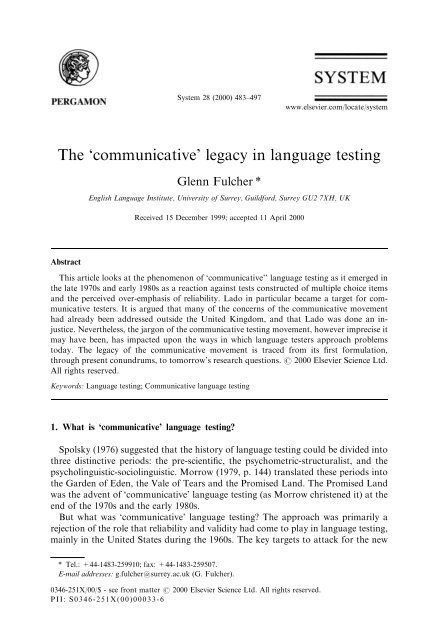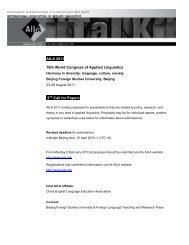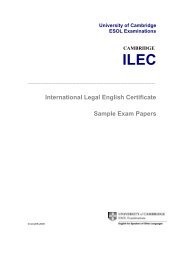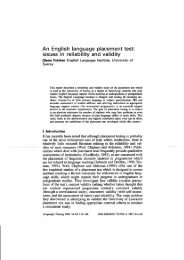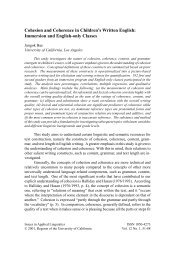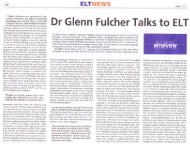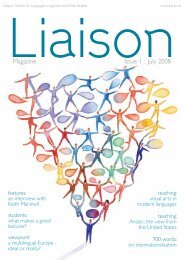The `communicative' legacy in language testing
The `communicative' legacy in language testing
The `communicative' legacy in language testing
You also want an ePaper? Increase the reach of your titles
YUMPU automatically turns print PDFs into web optimized ePapers that Google loves.
System 28 (2000) 483±497www.elsevier.com/locate/system<strong>The</strong> <strong>`communicative'</strong> <strong>legacy</strong> <strong>in</strong> <strong>language</strong> test<strong>in</strong>gGlenn Fulcher *English Language Institute, University of Surrey, Guildford, Surrey GU2 7XH, UKReceived 15 December 1999; accepted 11 April 2000AbstractThis article looks at the phenomenon of <strong>`communicative'</strong>' <strong>language</strong> test<strong>in</strong>g as it emerged <strong>in</strong>the late 1970s and early 1980s as a reaction aga<strong>in</strong>st tests constructed of multiple choice itemsand the perceived over-emphasis of reliability. Lado <strong>in</strong> particular became a target for communicativetesters. It is argued that many of the concerns of the communicative movementhad already been addressed outside the United K<strong>in</strong>gdom, and that Lado was done an <strong>in</strong>justice.Nevertheless, the jargon of the communicative test<strong>in</strong>g movement, however imprecise itmay have been, has impacted upon the ways <strong>in</strong> which <strong>language</strong> testers approach problemstoday. <strong>The</strong> <strong>legacy</strong> of the communicative movement is traced from its ®rst formulation,through present conundrums, to tomorrow's research questions. # 2000 Elsevier Science Ltd.All rights reserved.Keywords: Language test<strong>in</strong>g; Communicative <strong>language</strong> test<strong>in</strong>g1. What is <strong>`communicative'</strong> <strong>language</strong> test<strong>in</strong>g?Spolsky (1976) suggested that the history of <strong>language</strong> test<strong>in</strong>g could be divided <strong>in</strong>tothree dist<strong>in</strong>ctive periods: the pre-scienti®c, the psychometric-structuralist, and thepsychol<strong>in</strong>guistic-sociol<strong>in</strong>guistic. Morrow (1979, p. 144) translated these periods <strong>in</strong>tothe Garden of Eden, the Vale of Tears and the Promised Land. <strong>The</strong> Promised Landwas the advent of <strong>`communicative'</strong> <strong>language</strong> test<strong>in</strong>g (as Morrow christened it) at theend of the 1970s and the early 1980s.But what was <strong>`communicative'</strong> <strong>language</strong> test<strong>in</strong>g? <strong>The</strong> approach was primarily arejection of the role that reliability and validity had come to play <strong>in</strong> <strong>language</strong> test<strong>in</strong>g,ma<strong>in</strong>ly <strong>in</strong> the United States dur<strong>in</strong>g the 1960s. <strong>The</strong> key targets to attack for the new* Tel.: +44-1483-259910; fax: +44-1483-259507.E-mail addresses: g.fulcher@surrey.ac.uk (G. Fulcher).0346-251X/00/$ - see front matter # 2000 Elsevier Science Ltd. All rights reserved.PII: S0346-251X(00)00033-6
484 G. Fulcher / System 28 (2000) 483±497<strong>`communicative'</strong> <strong>language</strong> testers were the multiple-choice item as embodied <strong>in</strong> theTest of English as a Foreign Language (Spolsky, 1995), and the work of Lado(1961).Morrow (1979, pp. 146±147) characterised reliability (as de®ned by Lado) as thesearch for objectivity (<strong>in</strong> the use of multiple choice items), conveniently ignor<strong>in</strong>gthe dist<strong>in</strong>ction that Lado made between `reliability' and `scorability' (Lado, 1961,p. 31). Morrow further claimed that with the exception of face validity (and possiblypredictive validity) the whole concept of validity is circular because it only exists <strong>in</strong>terms of criteria, all of which are relative and based upon questionable assumptions.It was the task of the communicative <strong>language</strong> tester to re-de®ne reliability andvalidity. In order to do this, early communicative <strong>language</strong> testers latched ontoDavies' (1978) argument that there was a ``tension'' between reliability and validity,and de®ned validity as the parallelism of real-world activities and test tasks. Thismeant that validity <strong>in</strong>volved mak<strong>in</strong>g the test truer to an activity that would takeplace <strong>in</strong> the real world. Yet, reliability could only be <strong>in</strong>creased through us<strong>in</strong>g objectiveitem types like multiple choice. As Underhill (1982, p. 18) argued: ``there is noreal-life situation <strong>in</strong> which we go around ask<strong>in</strong>g or answer<strong>in</strong>g multiple choice questions.''(It should also be remembered that at this time validity was perceived to be aquality of the test, which is no longer the case.)Thus, the more validity a test had, the less reliability it had, and vice versa. Thiswas expressed most clearly <strong>in</strong> Underhill (1982, p. 17) when he wrote:If you believe that real <strong>language</strong> use only occurs <strong>in</strong> creative communicationbetween two or more parties with genu<strong>in</strong>e reasons for communication, then youmay accept that the trade-o€ between reliability and validity is unavoidable.Similarly, Morrow (1979, p. 151) had argued that, ``Reliability, while clearlyimportant, will be subord<strong>in</strong>ate to face validity.'' That is, the key criterion <strong>in</strong> identify<strong>in</strong>ga good test is that it looks like a good one, the <strong>in</strong>put appears to be ``authentic'',and the task or item type mirrors an act of communication <strong>in</strong> the real world (Morrow,1982, pp. 56±57). Carroll (1982, p. 1) went as far as to say that, ``<strong>The</strong> communicativeapproach stands or falls by the degree of real life, or at least life-like,communication that is achieved...''It was argued that communicative tests would <strong>in</strong>volve performance (speak<strong>in</strong>g),and the performance would be judged subjectively, qualitatively and impressionistically,by a sympathetic <strong>in</strong>terlocutor/assessor. It is not <strong>in</strong>signi®cant that Carroll's(1980) book was entitled ``Test<strong>in</strong>g Communicative Performance'', rather than``Test<strong>in</strong>g Communicative Competence'', pick<strong>in</strong>g up the view ®rst expressed byMorrow (1979, p. 151) that `communicative tests' will always <strong>in</strong>volve performance.<strong>The</strong> buzz words of early communicative <strong>language</strong> test<strong>in</strong>g soon became:1. real life tasks;2. face validity;3. authenticity; and4. performance.
G. Fulcher / System 28 (2000) 483±497 485In the journey to the promised land, Morrow (1979, p. 156) prophesied that,``...there is some blood to be spilt yet.'' Underhill (1982, p. 18) preached: ``As yeteach, so shall ye test.'' <strong>The</strong> communicative movement soon developed an antipathyto statistical analysis and <strong>language</strong> test<strong>in</strong>g research, <strong>in</strong> which the ``cult of the <strong>language</strong>test<strong>in</strong>g expert'' was deplored (Underhill, 1987, p. 1), and ``common sense''portrayed as more important than ``the statistical sausage mach<strong>in</strong>e'' (ibid, p. 105). 1Morrow (1991, p. 116) wrote of <strong>language</strong> test<strong>in</strong>g research that:At its worst, it might tempt us to paraphrase Oscar Wilde's epigram about theEnglish upper classes and their fondness for fox hunt<strong>in</strong>g. Wilde spoke of`<strong>The</strong> English country gentleman gallop<strong>in</strong>g after a fox Ð the unspeakable <strong>in</strong> fullpursuit of the uneatable'. Language test<strong>in</strong>g researchers may not be unspeakable;but they may well be <strong>in</strong> search of the unmeasurable.Perhaps popular communicative <strong>language</strong> test<strong>in</strong>g of this type was neither revolutionnor evolution. It was rebellion aga<strong>in</strong>st a perceived lack of concern for the <strong>in</strong>dividual,the human, the ``subject'' tak<strong>in</strong>g the test; it wished to remove the use of socalled``arcane pseudo-scienti®c jargon'', and rejoice <strong>in</strong> the common sense of theclassroom teacher who can tell whether a test is good or not by look<strong>in</strong>g at it; it wishedto ``re-humanise'' assessment. Indeed, Morrow (1991, p. 117) referred to ``ethicalvalidity'', and asked whether test<strong>in</strong>g would make a di€erence to the quality of life ofthe test-taker. He perceived this particularly <strong>in</strong> terms of washback. However, he alsorecommended that test-takers should be ``genu<strong>in</strong>ely <strong>in</strong>volved <strong>in</strong> the process'' ofassessment Ð although what this might mean <strong>in</strong> practice was not explored.2. Was this all so new?<strong>The</strong> new communicative <strong>language</strong> testers believed that the promised land o€eredsometh<strong>in</strong>g di€erent and better from everyth<strong>in</strong>g that had gone before (Harrison,1983). But as Spolsky (1995) and Barnwell (1996) rem<strong>in</strong>d us, the work of those whohave gone before is always <strong>in</strong> danger of be<strong>in</strong>g forgotten (or even misrepresented),which is precisely what happened <strong>in</strong> the early communicative <strong>language</strong> test<strong>in</strong>gmovement.Indeed, many of the calls for change are rem<strong>in</strong>iscent of debates that had takenplace decades before. Speak<strong>in</strong>g tests had been common <strong>in</strong> the United States s<strong>in</strong>ce thelate 1800s, and there is early evidence of <strong>in</strong>novative task types, such as ask<strong>in</strong>g alearner to <strong>in</strong>terpret between two raters (Lundeberg, 1929). Nevertheless, it is true tosay that throughout the 1920s, the heyday of <strong>language</strong> test development (Spolsky,1995, pp. 33±51), and <strong>in</strong>to the 1960s, the focus of <strong>language</strong> test<strong>in</strong>g was on deliver<strong>in</strong>glarge numbers of tests each year with<strong>in</strong> a rapidly expand<strong>in</strong>g education system <strong>in</strong> the1 Even though ``Common sense might be embarrassed <strong>in</strong> defend<strong>in</strong>g its position aga<strong>in</strong>st the awkwardfact which has been adduced, that even <strong>in</strong> the best regulated exam<strong>in</strong>ations one exam<strong>in</strong>er occasionallydi€ers from another to the extent of 50 percent.'' (Edgeworth, 1890, p. 661)
486 G. Fulcher / System 28 (2000) 483±497United States. <strong>The</strong> answer to this problem was the `new-type' test made up of multiplechoice items. <strong>The</strong> multiple choice item was born out of the need to producetests on an <strong>in</strong>dustrial scale, and their use was perpetuated through the developmentof new automatic mark<strong>in</strong>g mach<strong>in</strong>es that were designed especially to process multiplechoice items (Fulcher, 2000). Facts not taken <strong>in</strong>to account by the communicativecritics of large-scale tests.Communicative <strong>language</strong> testers also seem to have thought that their concernsabout multiple choice items were new, but this was far from the case. Mercier (1933,p. 382) was just one of the few early writers to express concern that the item formatelicited ``passive'' rather than ``dynamic'' knowledge, which might limit the generalisabilityof scores to <strong>language</strong> use. Further, <strong>language</strong> testers from the 1920s didrealise that it was important to have <strong>in</strong>dividualised tests of speak<strong>in</strong>g us<strong>in</strong>g questionsand conversational prompts (Wood, 1927), but that such tests were not practicalwhen deliver<strong>in</strong>g tests on an <strong>in</strong>dustrial scale (Hayden, 1920).Apart from practicality there was one further reason why speak<strong>in</strong>g tests were notdeveloped for large-scale use at the time. This was the deep concern about reliability,where the `subjective' judgement of an <strong>in</strong>dividual scorer dictated test outcome.Nevertheless, <strong>in</strong> the United States the College Boards test <strong>in</strong> English as a ForeignLanguage used throughout the 1920s and 1930s <strong>in</strong>cluded a 15-m<strong>in</strong> oral <strong>in</strong>terview aspart of the test battery (Barnwell, 1996, p. 70). However, the <strong>language</strong> sample wasgraded for pronunciation, as this was considered more reliable than any other criteriathat might have been used.With the Second World War, however, the ability to communicate <strong>in</strong> a second<strong>language</strong> became the explicit goal of teach<strong>in</strong>g programmes. <strong>The</strong>se teach<strong>in</strong>g programmesdepended more upon cont<strong>in</strong>ual assessment, and new tests were notimmediately developed to rate the personnel be<strong>in</strong>g tra<strong>in</strong>ed <strong>in</strong> foreign <strong>language</strong>s.However, the war experience was undoubtedly the beg<strong>in</strong>n<strong>in</strong>g of the modern test<strong>in</strong>gof speak<strong>in</strong>g and <strong>`communicative'</strong> test<strong>in</strong>g (Fulcher, 1998a). Kaulfers (1944, p. 137),for example, wrote that tests:...should provide speci®c, recognizable evidence of the exam<strong>in</strong>ee's read<strong>in</strong>ess toperform <strong>in</strong> a life-situation, where lack of ability to understand and speakextemporaneously might be a serious handicap to safety and comfort, or to thee€ective execution of military responsibilities.In the British tradition too, there had always been speak<strong>in</strong>g tests. However, thesemay have put test-takers at more of a disadvantage, because they were based onread<strong>in</strong>g aloud and understand<strong>in</strong>g extensive literary texts about which they had toexpress op<strong>in</strong>ions (Spolsky, 1995, pp. 205±205). Further, there was little of the concernfor test reliability that had emerged <strong>in</strong> the United States. Into the 1950s and1960s whilst British test developers were argu<strong>in</strong>g over whether multiple choice itemsshould be allowed <strong>in</strong>to their tests, and whether the literature requirement should bebrought more up to date, test<strong>in</strong>g agencies <strong>in</strong> the United States were develop<strong>in</strong>g the®rst true communicative performance tests that were to become the models forfuture test design and development around the world.
G. Fulcher / System 28 (2000) 483±497 487<strong>The</strong> Foreign Service Institute (FSI) speak<strong>in</strong>g test of 1956 was the ®rst test ofspeak<strong>in</strong>g ability that required conversation with a tra<strong>in</strong>ed rater (Sollenberger, 1978).<strong>The</strong> greater part of the test had been developed as early as 1952, and <strong>in</strong> 1958 subscalesof accent, comprehension, ¯uency, grammar and vocabulary were added(although not used for <strong>in</strong>itial rat<strong>in</strong>gs). So successful was the FSI oral pro®ciency<strong>in</strong>terview that its use spread to the CIA, the Defense Language Institute and thePeace Corps. By 1968 a standard speak<strong>in</strong>g test was produced for all these organisations<strong>in</strong> the form of the Interagency Language Roundtable speak<strong>in</strong>g test (Lowe,1983). In the 1970s this approach spread to schools and colleges <strong>in</strong> the United States(Lisk<strong>in</strong>-Gasparro, 1984), and many <strong>in</strong>novative programmes, <strong>in</strong>clud<strong>in</strong>g rater tra<strong>in</strong><strong>in</strong>g,were developed and dissem<strong>in</strong>ated (Adams and Frith, 1979). <strong>The</strong> rat<strong>in</strong>g scales, asthey eventually applied to schools and colleges, were developed by the AmericanCouncil on the Teach<strong>in</strong>g of Foreign Languages, published <strong>in</strong> 1982 (draft) and 1986(®nal). <strong>The</strong> format and number of bands were a direct result of research <strong>in</strong>to scalesensitivity conducted two decades earlier (Carroll, 1961).In addition to these developments a great deal of research <strong>in</strong>to the reliability andvalidity of these tests was undertaken. In the British context, under the grip of thecommunicative school, such research was not generally conducted because of faith<strong>in</strong> face validity. Indeed, as late as 1990 <strong>in</strong> the ®rst reference to a reliability studyus<strong>in</strong>g University of Cambridge Local Exam<strong>in</strong>ation Syndicate tests, Bachman andDavidson (1990, pp. 34±35) report that reliability coecients were not available forspeak<strong>in</strong>g tests because they were never double scored. This echoed fears expressedearlier by researchers such as Hamp-Lyons (1987, p. 19). Despite the publicationof the ALTE Code of Practice <strong>in</strong> 1994, committ<strong>in</strong>g European exam<strong>in</strong>ation boards tothe production of appropriate data, such basic statistical <strong>in</strong>formation has yet to bepublished (Chalhoub-Deville and Turner, 2000).3. Re<strong>in</strong>stat<strong>in</strong>g Lado<strong>The</strong> preced<strong>in</strong>g brief review shows that the communicative <strong>language</strong> test<strong>in</strong>g movement<strong>in</strong> the late 1970s and early 1980s was an unusual blip <strong>in</strong> the development of<strong>language</strong> test<strong>in</strong>g. As a primarily British phenomenon, it has left its mark on thepolicy and practice of British EFL boards <strong>in</strong> the focus on face validity, `authentic'look<strong>in</strong>g tasks, and a dearth of research Ð if not an actual disda<strong>in</strong> of research Ð asdemonstrated by Alderson and Buck (1993). This situation was predictable partlybecause the communicative test<strong>in</strong>g movement was essentially a rebellion particularlyaga<strong>in</strong>st reliability, as perceived <strong>in</strong> the work of Lado (1961). Yet, this perceptionwas one that did not, and does not, match the content of Lado's work. With h<strong>in</strong>dsight,one must wonder if British critics of the late 1970s had actually read Lado atall. Lado (p. 239) wrote that: ``<strong>The</strong> ability to speak a foreign <strong>language</strong> is withoutdoubt the most prized <strong>language</strong> skill, and rightly so...''. He went on, however, toexpla<strong>in</strong> that the test<strong>in</strong>g of speak<strong>in</strong>g was the least developed area of <strong>language</strong> test<strong>in</strong>g,and that this ``...is probably due <strong>in</strong> part at least to a lack of clear understand<strong>in</strong>g ofwhat constitutes speak<strong>in</strong>g ability or oral production.'' <strong>The</strong> construct of ``speak<strong>in</strong>g''
488 G. Fulcher / System 28 (2000) 483±497was under-de®ned. Lado was deeply concerned about correctly classify<strong>in</strong>g students<strong>in</strong>to <strong>language</strong> ability levels, and was thus <strong>in</strong>terested <strong>in</strong> reliability. He argued thatbecause of the complexity of <strong>language</strong> production and the non-<strong>language</strong> factors<strong>in</strong>volved, reliability was dicult to obta<strong>in</strong>. Validity and reliability were <strong>in</strong>extricablybound together. He was also keenly aware of other problems, as this quotation(Lado, p. 240) makes clear:Speak<strong>in</strong>g ability is described as the ability to express oneself <strong>in</strong> life situations,or the ability to report acts or situations <strong>in</strong> precise words, or the ability toconverse, or to express a sequence of ideas ¯uently.... This approach producestests that must range over a variety of situations to achieve validity,and then there is no assurance that the <strong>language</strong> elements of speak<strong>in</strong>g havebeen adequately sampled. Scor<strong>in</strong>g is done by means of a rat<strong>in</strong>g scaledescrib<strong>in</strong>g the type of responses to be expected and the score to assign toeach.Lado therefore argued that it was better to test speak<strong>in</strong>g through the ``<strong>language</strong>elements'' that were needed to communicate. He was aware of the problem of sampl<strong>in</strong>gsituations <strong>in</strong> performance tests <strong>in</strong> such a way that task could be matched toabilities, so that claims about abilities would be valid and generalisable to othersituations (with<strong>in</strong> what would now be called a doma<strong>in</strong> behaviour paradigm). However,a speak<strong>in</strong>g test would still <strong>in</strong>volve the learner speak<strong>in</strong>g, as it is necessary <strong>in</strong>Lado's view to test the ability to produce <strong>language</strong> at a speed that is comparable tothat of a native speaker (Lado's de®nition of ``¯uency''). Many of the activity typeslisted by Lado (1961, pp. 244±245) are not dissimilar to those of Underhill (1987) <strong>in</strong>sections labelled ``picture series'', ``susta<strong>in</strong>ed speech'', and ``conversation''. <strong>The</strong> susta<strong>in</strong>edspeech is essentially a role play conducted between the rater and the testtaker.<strong>The</strong> di€erence lies <strong>in</strong> Lado's awareness of the measurement requirements, thel<strong>in</strong>k to careful task and scale design, and construct de®nition.With sections entitled ``Test<strong>in</strong>g the Integrated Skills'' and ``Beyond Language:How to test cross-cultural understand<strong>in</strong>g,'' Davies (1978, p. 133) was surely correctwhen he wrote ``there is more to Lado than analytical tests...''.<strong>The</strong> British communicative test<strong>in</strong>g movement of the late 1970s and early 1980swas therefore lobby<strong>in</strong>g for tests and task types that were already be<strong>in</strong>g developedoutside the United K<strong>in</strong>gdom (see also Lowe, 1976), and simultaneously h<strong>in</strong>der<strong>in</strong>gthe pursuit of any systematic research agenda <strong>in</strong> <strong>language</strong> test<strong>in</strong>g that could addressLado's worries. Particularly <strong>in</strong> the ®eld of test<strong>in</strong>g speak<strong>in</strong>g, little research has beendone with<strong>in</strong> British test<strong>in</strong>g organisations to seek answers to many of the key questionsrelat<strong>in</strong>g to reliability, rat<strong>in</strong>g scale design and construction, test-taker characteristics,task variance, test-method facets, generalisability, and constructde®nition. Nevertheless, the fact that the jargon of British communicative <strong>language</strong>test<strong>in</strong>g spread rapidly has impacted upon the direction of <strong>language</strong> test<strong>in</strong>g research.In what follows, I will look at the criteria of a communicative test set out <strong>in</strong> 1979,and consider how these criteria have been developed <strong>in</strong> ways that provide new<strong>in</strong>sights <strong>in</strong>to <strong>language</strong> test<strong>in</strong>g.
4. What is a <strong>`communicative'</strong> test?Morrow (1979) claimed that there were speci®c criteria that could be used to tell ifa test is communicative. In an early commentary, Alderson (1981, p. 48) argued thatcommunicative testers had failed to show: (1) how traditional <strong>language</strong> tests (unde-®ned) fail to <strong>in</strong>corporate these criteria; and (2) how the criteria could be <strong>in</strong>corporated<strong>in</strong>to communicative <strong>language</strong> tests. Nevertheless, these criteria (and theassociated buzzwords) have left a <strong>legacy</strong> <strong>in</strong> <strong>language</strong> test<strong>in</strong>g research because ofthe wide acceptance of `the communicative approach'. This, <strong>in</strong> turn, has impactedupon <strong>language</strong> testers, who have developed new ways of look<strong>in</strong>g at <strong>language</strong>assessment as a result.4.1. Communicative tests <strong>in</strong>volve performanceG. Fulcher / System 28 (2000) 483±497 4891. Performance: test-takers should actually have to produce <strong>language</strong>.2. Interaction-based: there will be actual ``face-to-face oral <strong>in</strong>teraction which<strong>in</strong>volves not only the modi®cation of expression and content...but also anamalgam of receptive and productive skills'' (Morrow, 1979, p. 149).3. Unpredictability: Language use <strong>in</strong> real-time <strong>in</strong>teraction is unpredictable.Spolsky (1995) has shown that performance tests, <strong>in</strong> which learners take part <strong>in</strong>extended discourse of some form, have been <strong>in</strong> use for decades, if not centuries. <strong>The</strong>assumption underly<strong>in</strong>g the performance tests advocated and developed <strong>in</strong> the 1980swas that the observation of behaviour that mirrored `real-world communication'would lead to scores that would <strong>in</strong>dicate whether the learner could perform <strong>in</strong> thereal world. This `real world' <strong>in</strong>volves <strong>in</strong>teraction, unpredictability 2 , and <strong>in</strong>tegrationof skills. <strong>The</strong> test and the criterion (real-world communication) are seen to beessentially the same, which led to the pre-em<strong>in</strong>ent position of sampl<strong>in</strong>g and contentanalysis as the primary approach to test validation <strong>in</strong> English for Academic Purposes(EAP) test<strong>in</strong>g (Fulcher, 1999). However, <strong>language</strong> testers are not usually<strong>in</strong>terested <strong>in</strong> mak<strong>in</strong>g a prediction from a test task only to the same task <strong>in</strong> the `realworld' Ð even though this is <strong>in</strong> itself an <strong>in</strong>ference <strong>in</strong> need of validation. From asample performance, the <strong>in</strong>ference we need to make is usually to a range of potentialperformances, often as wide as ``able to survive <strong>in</strong> an English medium University''.For this, the performance is merely the vehicle for ``gett<strong>in</strong>g to'' underly<strong>in</strong>g abilities,which are hypothesised to enable a range of behaviours relevant to the criterionsituation(s) to which the tester wishes to predict. <strong>The</strong> requirement that we validate<strong>in</strong>ferences drawn from scores, which are abstractions based on sample performances,is now recognised. Research <strong>in</strong> this area is set to cont<strong>in</strong>ue well <strong>in</strong>to the newcentury (Messick, 1994; McNamara, 1996).2 Unpredictability is not discussed <strong>in</strong> this paper. <strong>The</strong> `open choice' pr<strong>in</strong>ciple upon which the unpredictabilityargument rests has been laid to rest, and discourse analysts have demonstrated that much <strong>language</strong>production is <strong>in</strong> fact highly predictable (S<strong>in</strong>clair, 1987).
490 G. Fulcher / System 28 (2000) 483±497A <strong>legacy</strong> that is only just beg<strong>in</strong>n<strong>in</strong>g to be <strong>in</strong>vestigated is the `amalgam' of skills, or<strong>in</strong> its modern <strong>in</strong>carnation, the use of <strong>in</strong>tegrative tasks <strong>in</strong> <strong>language</strong> tests. 3 Earlycommunicative <strong>language</strong> tests were certa<strong>in</strong>ly di€erent <strong>in</strong> the degree to which <strong>in</strong>tegrationwas achieved, not <strong>in</strong> the sense of the term used by Oller (1979), but thedeliberate thematic l<strong>in</strong>k<strong>in</strong>g of test tasks, and the <strong>in</strong>troduction of dependencies suchas speak<strong>in</strong>g based on a listen<strong>in</strong>g passage, where ``a dependency must be accountedfor'' (Mislevy, 1995, p. 363). Admittedly, the ``Communicative Use of English as aForeign Language'' (CUEFL, RSA) went particularly far <strong>in</strong> this, with no `pure'scores for skills of <strong>language</strong>, but for task ful®lment (Morrow, 1977). Hargreaves(1987) reported that the ma<strong>in</strong> problems associated with this test (and similar tests)were ``standardisation'' (usually referred to as equat<strong>in</strong>g forms), and scor<strong>in</strong>g. Tothese problems, Lewkowicz (1998) adds the fact that fewer tasks can be used <strong>in</strong> testsif they are not to become impractical, and tasks are more dicult and expensive toconstruct. Furthermore, reliability is associated with test length, and tests with<strong>in</strong>tegrated tasks may therefore need to be analysed <strong>in</strong> new and <strong>in</strong>novative ways.<strong>The</strong>se problems currently seem <strong>in</strong>surmountable, but cont<strong>in</strong>ued research <strong>in</strong>to thereliable use of <strong>in</strong>tegrated tasks <strong>in</strong> performance tests will be one of the most importantpositive legacies of the communicative movement for the next few decades.4.2. Communicative tests are authentic1. Purpose: the test-taker must be able to recognise communicative purpose andbe able to respond appropriately.2. Authenticity: <strong>in</strong>put and prompts <strong>in</strong> the <strong>language</strong> test should not be simpli®edfor the learner.3. Context: <strong>language</strong> will vary from context to context; some talk will be appropriate<strong>in</strong> one context and not another. <strong>The</strong> test-taker must therefore be testedon his/her ability to cope with the context of situation (physical environment,status of participants, the degree of formality, and express<strong>in</strong>g di€erent attitudes),as well as the l<strong>in</strong>guistic context.Language for Speci®c Purpose (LSP), and more speci®cally EAP bene®tted immediatelyand directly from the communicative movement. Carroll (1980, 1981, 1982)and Carroll and Hall (1985) took the pr<strong>in</strong>ciples of Munby (1978) and Wilk<strong>in</strong>s (1976)to develop a framework for EAP test design, meet<strong>in</strong>g the requirement of Morrow(1979) that test content should be tailored to learn<strong>in</strong>g needs, or purpose of communication.However, LSP test<strong>in</strong>g has been plagued by the seem<strong>in</strong>g impossibility ofde®n<strong>in</strong>g what is `speci®c' to a particular communicative sett<strong>in</strong>g or purpose. Fulcher(1999) summarises the ma<strong>in</strong> ®nd<strong>in</strong>gs of the ®eld to date:1. <strong>language</strong> knowledge (<strong>in</strong> its most general sense) accounts for most score variance<strong>in</strong> EAP tests;3 As <strong>in</strong> everyth<strong>in</strong>g, <strong>in</strong>tegrated test<strong>in</strong>g as currently be<strong>in</strong>g discussed is not new. Carroll (1961) ®rst<strong>in</strong>troduced the term, and Perren (1968) discussed the technical problems of <strong>in</strong>tegrated test<strong>in</strong>g and deal<strong>in</strong>gwith item and task dependency <strong>in</strong> the ``modern'' sense.
G. Fulcher / System 28 (2000) 483±497 4912. grammar modules are better predictors of test total score than subject speci®cmodules 4 ; and3. expert (content) judges cannot say what makes a text speci®c to their ®eld.<strong>The</strong> look and feel of EAP tests as they have evolved to date is likely to rema<strong>in</strong> primarilybecause they `look good' and encourage teachers and learners to focus onwhat is considered to be important <strong>in</strong> the classroom (Alderson, 1993, p. 216; Clapham,1996, p. 201) rather than any empirical argument for their usefulness <strong>in</strong> test<strong>in</strong>g(Clapham, 2000).Perhaps more important is the role of context <strong>in</strong> its broadest sense. It has beenrecognised for some years that contextual variables <strong>in</strong> the test<strong>in</strong>g situation impactupon discourse produced, and sometimes also upon test scores. This awareness hasled <strong>language</strong> testers to conduct research <strong>in</strong>to these variables, usually under theassumption that score variance which can be attributed to them constitutes systematicconstruct irrelevant variance. However, the view has been expressed thatconstructs as traditionally conceived by <strong>language</strong> testers cannot exist, because thereis no such th<strong>in</strong>g as competence, only variable performance and variable capacity(Tarone, 1998). Every change <strong>in</strong> context results <strong>in</strong> di€erent performance. Accept<strong>in</strong>gthis extreme view from SLA research, Skehan (1987, p. 200) concluded that <strong>language</strong>test<strong>in</strong>g was a matter of sampl<strong>in</strong>g, hence reduc<strong>in</strong>g the generalisability of testscores to the relationship between speci®c test task and its real-world counterpart.Tarone (p. 83) sees this as <strong>in</strong>creas<strong>in</strong>g validity while reduc<strong>in</strong>g reliability and generalisability.While the problems for <strong>language</strong> test<strong>in</strong>g are clear (Fulcher, 1995), it isequally true that one of the most important tasks of the com<strong>in</strong>g decade will be toidentify the level of generalisability that is permitted <strong>in</strong> mak<strong>in</strong>g <strong>in</strong>ferences fromscores across variable features of tasks. <strong>The</strong> most useful way of conceptualis<strong>in</strong>g thisdebate has been provided by Chapelle (1998), <strong>in</strong> which she dist<strong>in</strong>guishes between(the new) behaviourism, trait theory, and <strong>in</strong>teractionalism. While <strong>language</strong> testersare generally reluctant to abandon trait theory (and hence the treatment of contextualvariance as error), some aspects of context may need to be de®ned asconstruct rather than error if they are found to be part of the mean<strong>in</strong>g of test scores.<strong>The</strong> question that rema<strong>in</strong>s is how far down this road, towards the extreme variationistposition, <strong>language</strong> test<strong>in</strong>g will move <strong>in</strong> theory. However, <strong>in</strong> practice, it islikely that the position adopted on the cl<strong>in</strong>e <strong>in</strong> the development of any speci®c testwill be related to test purpose and the needs of score users, with the end of the cl<strong>in</strong>e<strong>in</strong> test<strong>in</strong>g for extremely speci®c purposes (Douglas, 1998, p. 152, 2000a, b).In early communicative texts, `authenticity' meant the use of material <strong>in</strong> promptsthat had not been written for non-native speakers of English, and a test could not be4 Davies (1978, p. 151) wrote: ``What rema<strong>in</strong>s a conv<strong>in</strong>c<strong>in</strong>g argument <strong>in</strong> favour of l<strong>in</strong>guistic competencetests (both discrete po<strong>in</strong>t and <strong>in</strong>tegrative) is that grammar is at the core of <strong>language</strong> learn<strong>in</strong>g...Grammaris far more powerful <strong>in</strong> terms of generalisability than any other <strong>language</strong> feature. <strong>The</strong>refore grammar maystill be the most salient feature to test.'' Language testers like Clapham (2000), as well as second <strong>language</strong>acquisition researchers, are now return<strong>in</strong>g to the study of grammar for precisely the reasons suggested byDavies. Bernhardt (1999, p. 4), for example, argues that, ``...second <strong>language</strong> read<strong>in</strong>g is pr<strong>in</strong>cipallydependent on grammatical ability <strong>in</strong> the second <strong>language</strong>''.
492 G. Fulcher / System 28 (2000) 483±497communicative unless it was authentic. This was termed a ``sterile argument'' byAlderson (1981, p. 48). Modern performance tests that attempt to mirror some criterionsituation <strong>in</strong> the external world are no more than role-plays or simulations, <strong>in</strong>which the learner is asked to `imag<strong>in</strong>e' that they are actually tak<strong>in</strong>g a patient'sdetails <strong>in</strong> a hospital, giv<strong>in</strong>g students a m<strong>in</strong>i-lecture, or engag<strong>in</strong>g is a bus<strong>in</strong>ess negotiation.Language tests by their very nature are not mirrors of real life, but <strong>in</strong>strumentsconstructed on the basis of a theory of the nature of <strong>language</strong>, of <strong>language</strong>use, and of <strong>language</strong> learn<strong>in</strong>g.Widdowson (1983, p. 30) drew a dist<strong>in</strong>ction between the simple notion of`authenticity' as conceived <strong>in</strong> early communicative writ<strong>in</strong>gs, and:...the communicative activity of the <strong>language</strong> user, to the engagement of <strong>in</strong>terpretativeprocedures for mak<strong>in</strong>g sense, even if these procedures are operat<strong>in</strong>gon and with textual data which are not authentic <strong>in</strong> the ®rst [<strong>language</strong> producedby native speakers for a normal communicative purpose] sense.In other words, the relationship between the learner and the task, how the learnerdeals with the task, and what we can learn about the learner as a result of do<strong>in</strong>g thetask, is what makes a task communicative.In the most recent formulation of authenticity, Bachman and Palmer (1996) dist<strong>in</strong>guishbetween authenticity (correspondence between test task characteristics andthe characteristics of a target <strong>language</strong> use task) and <strong>in</strong>teractiveness (abilitiesengaged by the task that are comparable to those engaged by the target <strong>language</strong> usesituation). <strong>The</strong> degree to which the task characteristics match is the degree of taskauthenticity, and relates directly to construct validity through the ability to generalisefrom test task to target <strong>language</strong> use task.This formulation comb<strong>in</strong>es previous de®nitions, relat<strong>in</strong>g the degree of authenticityachieved to the ``perceptions'' of authenticity by learners <strong>in</strong> speci®c situations(Lewkowicz, 2000, p. 49). In conjunction with a method for describ<strong>in</strong>g test andlearner characteristics, the reformulation may aid research <strong>in</strong>to construct validity <strong>in</strong>terms of how researchers hypothesise the construct operates over a range of di€erentcontexts <strong>in</strong> an <strong>in</strong>teractionalist framework that expects signi®cant score variationacross contexts (Chapelle, 1998, pp. 41±42; Douglas, 1998).However, Lewkowicz (1997, 2000) questions whether it is possible (or practical) tocarry out comparisons of test tasks and target <strong>language</strong> use tasks us<strong>in</strong>g the newtaxonomy of the Bachman and Palmer model, and also demonstrates that the perceptionof authenticity varies widely among test takers. Perhaps Chapelle (2000,p. 161) is right when she suggests that authenticity is a ``folk concept'', which mayjust be shorthand for `all those bits of reality that we can't list but are simpli®ed <strong>in</strong>models of test method/task facets'.It is here where models of communicative <strong>language</strong> ability and test method(Canale and Swa<strong>in</strong>, 1980, 1981; Bachman, 1990; Bachman and Palmer, 1996) aremost useful <strong>in</strong> <strong>language</strong> test<strong>in</strong>g research, whether the purpose is to isolate errorvariance or attempt to build task facets <strong>in</strong>to construct de®nition. Such models mayprovide a framework for empirical research that will help de®ne the constructs with
G. Fulcher / System 28 (2000) 483±497 493which <strong>language</strong> test developers work <strong>in</strong> the future. However, it should be rememberedthat models rema<strong>in</strong> abstractions of perceptions of reality (Mislevy, 1995,p. 344), and as such are themselves constructs. Inferences are drawn from test scoresto models of reality, and so the models rema<strong>in</strong> <strong>in</strong> need of validation Ð or the estimationof the usefulness of the model for the research for which it is be<strong>in</strong>g used(Fulcher, 1998b).4.3. Communicative tests are scored on real-life outcomesBehaviour-based: the only real criterion of success <strong>in</strong> a <strong>language</strong> test is thebehavioural outcome, or whether the learner was able to achieve the <strong>in</strong>tendedcommunicative e€ect.When students are asked to perform a task, it is essential to state what it is that theraters are measur<strong>in</strong>g. <strong>The</strong> ``behavioural outcomes'' of Morrow (1979) are dicult toisolate, and even more dicult to specify (Fulcher, 1999, pp. 224±225). And it is alsopossible for learners to successfully complete acts of communication with little or noknowledge of a <strong>language</strong>. In performance tests it is through the rat<strong>in</strong>g scale thatwhat is be<strong>in</strong>g tested is de®ned. In fact, more research has been carried out <strong>in</strong>to rat<strong>in</strong>gscales than any other aspect of tests of speak<strong>in</strong>g (Fulcher, 1998a), and it is perhapshere where the early British communicative movement has had no last<strong>in</strong>g <strong>legacy</strong> formodern test<strong>in</strong>g practice. Until recently, the template for rat<strong>in</strong>g scale design was theorig<strong>in</strong>al FSI, and rat<strong>in</strong>g scales designed for British tests have not fared well fromcritics (Fulcher, 1987; Wood, 1990).Most rat<strong>in</strong>g scale design has been a-theoretical, rely<strong>in</strong>g purely on arm-chairnotions of <strong>language</strong> development and structure. Only recently have empirical methodsbeen employed <strong>in</strong> the construction and validation of rat<strong>in</strong>g scales (Fulcher,1993, 1996; North, 1996; North and Schneider, 1998; Upshur and Turner, 1995).Research <strong>in</strong> this area is now grow<strong>in</strong>g (Turner, 1998), and as rat<strong>in</strong>g scales of morecomponents of models of communicative <strong>language</strong> ability are designed, operationalisedand used <strong>in</strong> research, <strong>language</strong> testers and SLA researchers will learnmore about <strong>language</strong> and how it is used across a range of tasks and target <strong>language</strong>use situations by speakers with di€erent characteristics.5. ConclusionMuch current research <strong>in</strong> <strong>language</strong> test<strong>in</strong>g may have developed despite the Britishcommunicative test<strong>in</strong>g movement. <strong>The</strong> concerns with <strong>language</strong> use that have generatedthe questions that are now be<strong>in</strong>g addressed already existed <strong>in</strong> the United States.However, the ideology associated with the early British communicative movementhas had a pervasive <strong>in</strong>¯uence on the ethos of teach<strong>in</strong>g, learn<strong>in</strong>g and test<strong>in</strong>g aroundthe world. It would be dicult to market a new large-scale test that did not claim tobe <strong>`communicative'</strong> Ð whatever the term may mean for di€erent users. <strong>The</strong> positive<strong>legacy</strong> of the movement as a whole can be seen <strong>in</strong> all the research that concerns itself
494 G. Fulcher / System 28 (2000) 483±497with more careful de®nitions of task, of context, and the relationship between testtask and the target <strong>language</strong> use situation. This is especially the case <strong>in</strong> test<strong>in</strong>g <strong>language</strong>for speci®c purposes. Yet, this research is be<strong>in</strong>g done with a rigour that wasrejected by the British communicative test<strong>in</strong>g movement, <strong>in</strong>volv<strong>in</strong>g the use of newstatistical tools and the development of sophisticated conceptual paradigms. Wemay even see the development of high quality tests conform<strong>in</strong>g to the standardsexpected <strong>in</strong> the United States (APA, 1999) with the attractive and creative content ofBritish tests. 5 Whatever speci®c bene®ts there may be, the uni®ed concept of validity,a generally accepted theoretical framework for research <strong>in</strong> educational assessment,and grow<strong>in</strong>g <strong>in</strong>terest <strong>in</strong> the ethics of <strong>language</strong> test<strong>in</strong>g 6 should lead to a decadeof cooperative research that will br<strong>in</strong>g signi®cant advances <strong>in</strong> <strong>language</strong> test<strong>in</strong>gtheory and practice.AcknowledgementsMy thanks are due to Bob Hill, whose observations on the vagueness of popularterm<strong>in</strong>ology <strong>in</strong> <strong>language</strong> test<strong>in</strong>g led me to consider the <strong>legacy</strong> of `communicativetest<strong>in</strong>g' at the start of a new decade. And to Fred Davidson who provided constructivecriticism on the ®rst draft of this paper. Responsibility for any errors, andthe views expressed, rema<strong>in</strong>s m<strong>in</strong>e.ReferencesAdams, M.L., Frith, J.R., 1979. Test<strong>in</strong>g Kit: French and Spanish. Department of State, Foreign ServiceInstitute, Wash<strong>in</strong>gton D.C.Alderson, J.C., 1981. Reaction to the Morrow Paper (3). In: Alderson, J.C., Hughes, A. (Eds.), Issues <strong>in</strong>Language Test<strong>in</strong>g. <strong>The</strong> British Council, London, pp. 45±54.Alderson, J.C., 1993. <strong>The</strong> relationship between grammar and read<strong>in</strong>g <strong>in</strong> an English for academic purposestest battery. In: Douglas, D., Chapelle, C. (Eds.), A New Decade <strong>in</strong> Language Test<strong>in</strong>g Research.TESOL Publications, Wash<strong>in</strong>gton DC, pp. 203±219.Alderson, J.C., Buck, G., 1993. Standards <strong>in</strong> test<strong>in</strong>g: a study of the practice of UK exam<strong>in</strong>ation boards <strong>in</strong>EFL/ESL test<strong>in</strong>g. Language Test<strong>in</strong>g 10 (1), 1±26.ALTE, 1994. <strong>The</strong> ALTE Code of Practice. Cambridge Local Exam<strong>in</strong>ations Syndicate, Cambridge.APA (American Educational Research Association, American Psychological Association, NationalCouncil on Measurement <strong>in</strong> Education), 1999. Standards for Educational and Psychological Test<strong>in</strong>g.AERA, Wash<strong>in</strong>gton DC.Bachman, L.F., 1976. Fundamental Considerations <strong>in</strong> Language Test<strong>in</strong>g. Oxford University Press,Oxford.Bachman, L.F., Davidson, F., 1990. <strong>The</strong> Cambridge-TOEFL comparability study: an example of thecross-national comparison of <strong>language</strong> tests. In: de Jong, H.A.L. (Ed.), Standardization <strong>in</strong> LanguageTest<strong>in</strong>g. AILA Review, Amsterdam, pp. 24±45.5 <strong>The</strong> TOEFL 2000 project may lead to the ®rst <strong>language</strong> test that achieves the <strong>in</strong>tegration of hightechnical quality, <strong>in</strong>novative task types, and construct frameworks that guide test design (Jamieson etal., 2000).6 See Messick (1981, 1984, 1989a, b, 1994).
G. Fulcher / System 28 (2000) 483±497 495Bachman, L.F., Palmer, A.S., 1996. Language Test<strong>in</strong>g <strong>in</strong> Practice. Oxford University Press, Oxford.Barnwell, D.P., 1996. A History of Foreign Language Test<strong>in</strong>g <strong>in</strong> the United States: From its Beg<strong>in</strong>n<strong>in</strong>gsto the Present Day. Bil<strong>in</strong>gual Press, Arizona.Bernhardt, E., 1999. If read<strong>in</strong>g is reader-based, can there be a computer adaptive test of read<strong>in</strong>g? In:Chalhoub-Deville, M. (Ed.), Issues <strong>in</strong> Computer-adaptive Test<strong>in</strong>g of Read<strong>in</strong>g Pro®ciency. CambridgeUniversity Press, Cambridge, pp. 1±10.Canale, M., Swa<strong>in</strong>, M., 1980. <strong>The</strong>oretical bases of communicative approaches to second <strong>language</strong> teach<strong>in</strong>gand test<strong>in</strong>g. Applied L<strong>in</strong>guistics 1 (1), 1±47.Canale, M., Swa<strong>in</strong>, M., 1981. A theoretical framework for communicative competence. In: Palmer, A.S.,Groot, P.J.M., Trosper, G.A. (Eds.), <strong>The</strong> Construct Validation of Tests of Communicative Competence.TESOL Publications, Wash<strong>in</strong>gton DC, pp. 31±35.Carroll, J.B., 1961. Fundamental considerations <strong>in</strong> test<strong>in</strong>g for English <strong>language</strong> pro®ciency of foreignstudents. In: Allen, H.B. (Ed.), Teach<strong>in</strong>g English as a Second Language. McGraw Hill, New York,pp. 364±372.Carroll, J.B., 1967. <strong>The</strong> foreign <strong>language</strong> atta<strong>in</strong>ments of <strong>language</strong> majors <strong>in</strong> the senior year: a surveyconducted <strong>in</strong> U.S. colleges and universities. Foreign Language Annals 1 (2), 131±151.Carroll, B.J., 1980. Test<strong>in</strong>g Communicative Performance: An Interim Study. Pergamon, Exeter.Carroll, B.J., 1981. Speci®cations for an English Language Test<strong>in</strong>g Service. In: Alderson, J.C., Hughes, A.(Eds.), Issues <strong>in</strong> Language Test<strong>in</strong>g. <strong>The</strong> British Council, London, pp. 68±110.Carroll, B.J., 1982. Language test<strong>in</strong>g: is there another way? In: Heaton, J.B. (Ed.), Language Test<strong>in</strong>g.Modern English Publications, London, pp. 1±10.Carroll, B.J., Hall, P.J., 1985. Make Your Own Language Tests: A Practical Guide to Writ<strong>in</strong>g LanguagePerformance Tests. Pergamon, Oxford.Chapelle, C., 1998. Construct de®nition and validity <strong>in</strong>quiry <strong>in</strong> SLA research. In: Bachman, L.F., Cohen,A.D. (Eds.), Interfaces Between Second Language Acquisition and Language Test<strong>in</strong>g Research. CambridgeUniversity Press, Cambridge, pp. 32±70.Chapelle, C., 2000. From read<strong>in</strong>g theory to test<strong>in</strong>g practice. In: Chalhoub-Deville, M. (Ed.), Issues <strong>in</strong>Computer-adaptive Test<strong>in</strong>g of Read<strong>in</strong>g Pro®ciency. Studies <strong>in</strong> Language Test<strong>in</strong>g, Vol. 10. CambridgeUniversity Press, Cambridge, pp. 150±166.Clapham, C., 1996. <strong>The</strong> Development of IELTS. A Study of the E€ect of Background Knowledge onRead<strong>in</strong>g Comprehension. Cambridge University Press, Cambridge.Davies, A., 1978. Language test<strong>in</strong>g. In: Language Teach<strong>in</strong>g and L<strong>in</strong>guistics Abstracts. Vol. 11, 3 & 4,repr<strong>in</strong>ted <strong>in</strong> K<strong>in</strong>sella, V. (Ed.) (1982) Surveys 1: Eight State-of-the-art Articles on Key Areas <strong>in</strong> LanguageTeach<strong>in</strong>g. Cambridge University Press, Cambridge, pp. 127±159.Douglas, D., 1998. Test<strong>in</strong>g methods <strong>in</strong> context-based SL research. In: Bachman, L.F., Cohen, A.D.(Eds.), Interfaces Between Second Language Acquisition and Language Test<strong>in</strong>g Research. CambridgeUniversity Press, Cambridge, pp. 141±155.Douglas, D., 2000a. Assess<strong>in</strong>g Languages for Speci®c Purposes. Cambridge University Press, Cambridge.Douglas, D., 2000b. Test<strong>in</strong>g for speci®c purposes. In: Fulcher, G., Thrasher, R. Video FAQs: Introduc<strong>in</strong>gTopics <strong>in</strong> Language Test<strong>in</strong>g. Available at: http://www.surrey.ac.uk/ELI/ilta/faqs/ma<strong>in</strong>.htmlEdgeworth, F.Y., 1890. <strong>The</strong> element of chance <strong>in</strong> competitive exam<strong>in</strong>ations. Journal of the Royal StatisticalSociety 49 (1), 644±663.Fulcher, G., 1987. Tests of oral performance: the need for data-based criteria. English Language Teach<strong>in</strong>gJournal 14 (4), 287±291.Fulcher, G., 1993. <strong>The</strong> construction and validation of rat<strong>in</strong>g scales for oral tests <strong>in</strong> English as a ForeignLanguage. Unpublished PhD thesis, University of Lancaster, UK.Fulcher, G., 1995. Variable competence <strong>in</strong> second <strong>language</strong> acquisition: a problem for research methodology.System 23 (1), 25±33.Fulcher, G., 1996. Does thick description lead to smart tests? A data-based approach to rat<strong>in</strong>g scaleconstruction. Language Test<strong>in</strong>g 13 (2), 208±238.Fulcher, G., 1998a. <strong>The</strong> test<strong>in</strong>g of speak<strong>in</strong>g <strong>in</strong> a second <strong>language</strong>. In: Clapham, C., Corson, D. (Eds.),Language Test<strong>in</strong>g and Assessment. Encyclopedia of Language and Education. Vol. 7. Kluwer AcademicPublishers, Dordrecht, pp. 75±86.
496 G. Fulcher / System 28 (2000) 483±497Fulcher, G., 1998b. Widdowson's model of communicative competence and the test<strong>in</strong>g of read<strong>in</strong>g: anexploratory study. System 26, 281±302.Fulcher, G., 1999. Assessment <strong>in</strong> English for Academic Purposes: putt<strong>in</strong>g content validity <strong>in</strong> its place.Applied L<strong>in</strong>guistics 20 (2), 221±236.Fulcher, G., 2000. Computers <strong>in</strong> <strong>language</strong> test<strong>in</strong>g. In: Brett, P., Motteram, G. (Eds.), Computers <strong>in</strong> LanguageTeach<strong>in</strong>g. IATEFL Publications, Manchester, pp. 97±111.Hamp-Lyons, L., 1987. Cambridge First Certi®cate <strong>in</strong> English. In: Alderson, J.C., Krahnke, K.J., Stans-®eld, C.W. (Eds.), Reviews of English Language Pro®ciency Tests. TESOL Publications, Wash<strong>in</strong>gtonDC, pp. 18±19.Hargreaves, P., 1987. Royal Society of Arts: exam<strong>in</strong>ations <strong>in</strong> the communicative use of English as aForeign Language. In: Alderson, J.C., Krahnke, K.J., Stans®eld, C.W. (Eds.), Reviews of EnglishLanguage Pro®ciency Tests. TESOL Publications, Wash<strong>in</strong>gton DC, pp. 32±34.Harrison, A., 1983. Communicative test<strong>in</strong>g: jam tomorrow? In: Hughes, A., Porter, D. (Eds.), CurrentDevelopments <strong>in</strong> Language Test<strong>in</strong>g. Academic Press, London, pp. 77±85.Hayden, P.M., 1920. Experience with oral exam<strong>in</strong>ations <strong>in</strong> modern <strong>language</strong>s. Modern Language Journal5, 87±92.Jamieson, J., Jones, S., Kirsch, I., Mosthenthal, P., Taylor, C., 2000. TOEFL 2000 framework: a work<strong>in</strong>gpaper. ETS: TOEFL Monograph Series 16, Pr<strong>in</strong>ceton NJ.Kaulfers, W., 1944. War-time developments <strong>in</strong> modern <strong>language</strong> achievement tests. Modern LanguageJournal 28, 136±150.Lado, R., 1961. Language Test<strong>in</strong>g: <strong>The</strong> Construction and Use of Foreign Language Tests. Longman,London.Lewkowicz, J.A., 1997. Authenticity for whom? Does authenticity really matter? In: Huhta, A., Kohonen,V., Lurki-Suonio, L., Luoma, S. (Eds.), Current Developments and Alternatives <strong>in</strong> Language Assessment.Jyvaskyla University, F<strong>in</strong>land, pp. 165±184.Lewkowicz, J.A., 1998. Integrated test<strong>in</strong>g. In: Clapham, C., Corson, D. (Eds.), Language Test<strong>in</strong>g andAssessment. Encyclopedia of Language and Education, Dordrecht: Kluwer Academic Publishers, Vol.7, pp. 121±130.Lewkowicz, J.A., 2000. Authenticity <strong>in</strong> <strong>language</strong> test<strong>in</strong>g: some outstand<strong>in</strong>g questions. Language Test<strong>in</strong>g17 (1), 43±64.Lisk<strong>in</strong>-Gasparro, J.E., 1984. <strong>The</strong> ACTFL pro®ciency guidel<strong>in</strong>es: gateway to test<strong>in</strong>g and curriculum.Foreign Language Annals 17 (5), 475±489.Lowe, P., 1976. Handbook on Question Types and the Use <strong>in</strong> the LS Oral Pro®ciency Tests. CIA LanguageSchool, Wash<strong>in</strong>gton DC.Lowe, P., 1983. <strong>The</strong> ILR oral <strong>in</strong>terview: orig<strong>in</strong>s, applications, pitfalls, and implications. Die Unterrichspraxis16, 230±244.Lundeberg, O.K., 1929. Recent developments <strong>in</strong> audition-speech tests. Modern Language Journal 14,193±202.McNamara, T., 1996. Measur<strong>in</strong>g Second Language Performance. Longman, London.Mercier, L., 1933. Diverg<strong>in</strong>g trends <strong>in</strong> modern foreign <strong>language</strong> teach<strong>in</strong>g and their possible reconciliation.French Review 6 (3), 370±386.Messick, S., 1981. Evidence and ethics <strong>in</strong> the evaluation of tests. Educational Researcher 10 (9), 9±20.Messick, S., 1984. Assessment <strong>in</strong> context: apprais<strong>in</strong>g student performance <strong>in</strong> relation to <strong>in</strong>structionalquality. Educational Researcher 13 (3), 3±8.Messick, S., 1989a. Validity. In: L<strong>in</strong>n, R.L. (Ed.), Educational Measurement. Macmillan, New York, pp.13±103.Messick, S., 1989b. Mean<strong>in</strong>g and values <strong>in</strong> test validation: the science and ethics of assessment. EducationalResearcher 18 (2), 5±11.Messick, S., 1994. <strong>The</strong> <strong>in</strong>terplay of evidence and consequences <strong>in</strong> the validation of performance assessments.Educational Researcher 23 (2), 13±23.Mislevy, R.J., 1995. Test theory and <strong>language</strong> learn<strong>in</strong>g assessment. Language Test<strong>in</strong>g 12 (3), 341±369.Morrow, K., 1977. Techniques of Evaluation for a National Syllabus. Royal Society of Arts,London.
G. Fulcher / System 28 (2000) 483±497 497Morrow, K., 1979. Communicative <strong>language</strong> test<strong>in</strong>g: revolution of evolution? In: Brum®t, C.K., Johnson,K. (Eds.), <strong>The</strong> Communicative Approach to Language Teach<strong>in</strong>g. Oxford University Press, Oxford,pp. 143±159.Morrow, K., 1982. Test<strong>in</strong>g spoken <strong>language</strong>. In: Heaton, J.B. (Ed.), Language Test<strong>in</strong>g. Modern EnglishPublications, London, pp. 56±58.Morrow, K., 1991. Evaluat<strong>in</strong>g communicative tests. In: Anivan, S. (Ed.), Current Developments <strong>in</strong> LanguageTest<strong>in</strong>g. RELC, S<strong>in</strong>gapore, pp. 111±118.Munby, J.L., 1978. Communicative Syllabus Design. Cambridge University Press, Cambridge.North, B., 1996. <strong>The</strong> development of a common framework scale of descriptors of <strong>language</strong> pro®ciencybased on a theory of measurement. Unpublished PhD thesis, Thames Valley University.North, B., Schneider, G., 1998. Scal<strong>in</strong>g descriptors for <strong>language</strong> pro®ciency scales. Language Test<strong>in</strong>g 15(2), 217±262.Oller, J., 1979. Language tests at School. London, Longman.Perren, G.E., 1968. Test<strong>in</strong>g spoken <strong>language</strong>: some unsolved problems. In: Davies, A. (Ed.), LanguageTest<strong>in</strong>g Symposium: A Psychol<strong>in</strong>guistic Approach. Oxford University Press, Oxford, pp. 107±116.S<strong>in</strong>clair, J. McH, 1987. Collocation: a progress report. In: Steele, R., Treadgold, T. (Eds.), Essays <strong>in</strong>Honour of Michael Halliday. John Benjam<strong>in</strong>s, Amsterdam, pp. 319±331.Skehan, P., 1987. Variability and <strong>language</strong> test<strong>in</strong>g. In: Ellis, R. (Ed.), Second Language Acquisition <strong>in</strong>Context. Prentice Hall, Hemel Hempstead, pp. 195±206.Sollenberger, H.E., 1978. Development and current use of the FSI oral <strong>in</strong>terview test. In: Clark, J.L.D.(Ed.), Direct Test<strong>in</strong>g of Speak<strong>in</strong>g Pro®ciency: <strong>The</strong>ory and Application. Educational Test<strong>in</strong>g Service,Pr<strong>in</strong>ceton, NJ, pp. 1±12.Spolsky, B., 1976. Language Test<strong>in</strong>g: Art of Science? Paper read at the 4th International Congress ofApplied L<strong>in</strong>guistics. Stuttgart, Germany.Spolsky, B., 1995. Measured Words. Oxford University Press, Oxford.Tarone, E., 1998. Research on <strong>in</strong>ter<strong>language</strong> variation: implications for <strong>language</strong> test<strong>in</strong>g. In: Bachman,L.F., Cohen, A.D. (Eds.), Interfaces Between Second Language Acquisition and Language Test<strong>in</strong>gResearch. University of Cambridge Press, Cambridge, pp. 71±89.Turner, J., 1998. Assess<strong>in</strong>g Speak<strong>in</strong>g. Annual Review of Applied L<strong>in</strong>guistics. Cambridge University Press,Cambridge, 192-207.Underhill, N., 1982. <strong>The</strong> great reliability validity trade-o€: problems <strong>in</strong> assess<strong>in</strong>g the productive skills. In:Heaton, J.B. (Ed.), Language Test<strong>in</strong>g. Modern English Publications, London, pp. 17±23.Underhill, N., 1987. Test<strong>in</strong>g Spoken Language. Cambridge University Press, Cambridge.Upshur, J.A., Turner, C.E., 1995. Construct<strong>in</strong>g rat<strong>in</strong>g scales for second <strong>language</strong> tests. English LanguageTeach<strong>in</strong>g Journal 49, 3±12.Widdowson, H.G., 1983. Learn<strong>in</strong>g Purpose and Language Use. Oxford University Press, Oxford.Wilk<strong>in</strong>s, D.A., 1976. Notional Syllabuses. Oxford University Press, Oxford.Wood, B.D., 1927. New York Experiments with New-Type Modern Language Tests. Macmillan, NewYork.Wood, R., 1990. Assessment and Test<strong>in</strong>g: A Survey of Research. Cambridge University Press, Cambridge.


